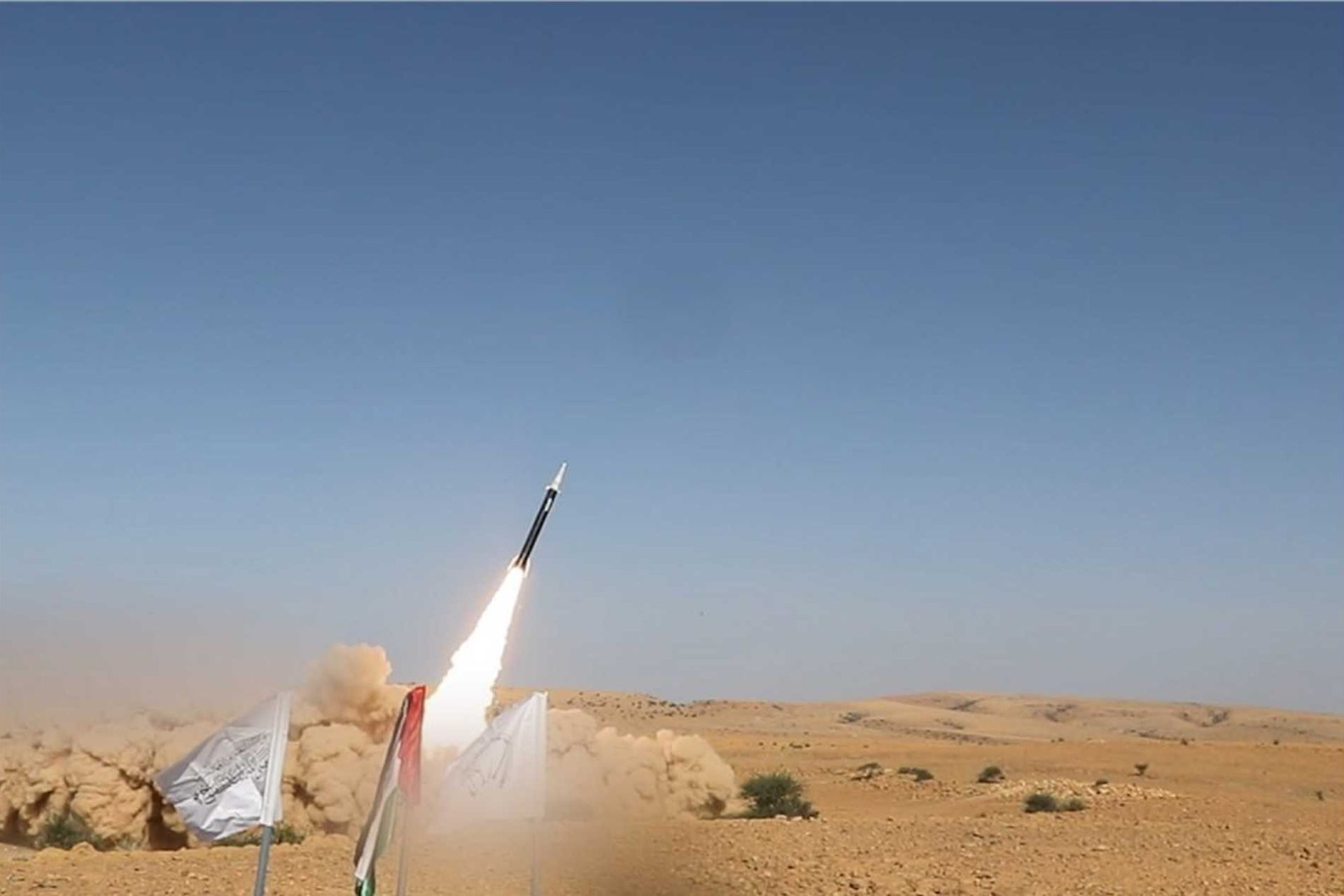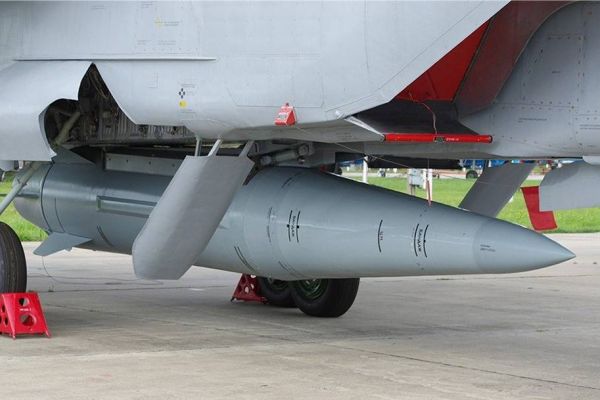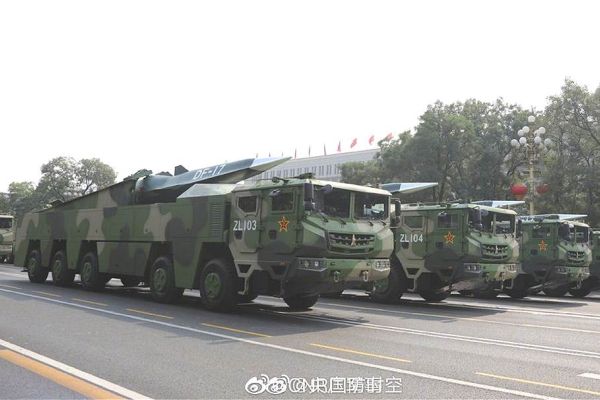Hypersonic Missiles.
Palestine-2 hypersonic missile.

The Palestine-2 is a hypersonic ballistic missile developed by the Ansar Allah (Houthi) movement in Yemen. It is a strategic weapon designed for long-range, high-speed strikes, capable of bypassing sophisticated missile defense systems. The missile has garnered international attention, particularly following its successful use in January 2025 when it struck a power plant in Haifa, Israel.
Country users: Houthi - Yemen
Description
The Palestine-2 is a two-stage solid-fuel hypersonic ballistic missile developed by Yemen's Ansar Allah (Houthi) movement with significant technological assistance from Iran. According to the design, it seems to be based on the Iranian-made Fateh-110 missile, a short-range ballistic missile (SRBM), with substantial modifications to enhance its range, speed, and maneuverability. The Palestine-2 has been developed as a more advanced variant of the Fateh-110. It incorporates improvements in its guidance systems, propulsion, and maneuverability, turning it into a hypersonic missile capable of achieving Mach 16 speeds.
The missile was developed as part of Yemen's larger missile program, which aims to increase its ability to strike key enemy targets deep within Israeli and Saudi territory. Yemen's Iranian-backed missile program has provided substantial expertise in missile technology, particularly in terms of solid-fuel propulsion systems and advanced guidance. The Palestine-2's development began in the early 2020s, with Iranian involvement ensuring that the missile could eventually achieve the hypersonic capabilities needed to bypass the most sophisticated defense systems in the region.
The Palestine-2 missile entered active service in late 2024, following a series of successful test launches, and it was first used operationally in December 2024. Its most recent deployment was in January 2025, when it struck a power plant in Haifa, Israel, marking a significant milestone in Yemen’s missile program. The missile’s performance in this strike was hailed as a major success, demonstrating its ability to reach critical targets in Israel and evade advanced defense systems.
Palestine-2 hypersonic missile variants:
No variants at this time.
Technical Data
-
Launcher Unit
The Palestine-2 missile is launched from a mobile ground-based platform, providing significant mobility and operational flexibility. The launch platform is mounted on a heavy-duty truck designed to carry and launch the missile from concealed locations. This mobile system enhances survivability in a contested environment, allowing for rapid repositioning and reducing the risk of the launcher being targeted by counter-strikes. The launcher's design supports the quick deployment and firing of the missile, ensuring that it can be used in various terrain and under operational stress.
The launch platform is rugged and capable of operating in difficult environments, from desert regions to mountainous terrains. The truck-mounted system allows for low-profile operation, helping to avoid detection by enemy reconnaissance systems. This mobility feature is a critical element ensuring the missile's effectiveness and survivability in battle.
Launcher Unit -
Missile
The Palestine-2 is a two-stage solid-fuel missile designed for high-speed, long-range strikes, which seems to be based on the Iranian-made Fateh-110. It can achieve Mach 16 speeds, which classifies it as a hypersonic missile. This high speed enables it to bypass traditional missile defense systems, making it a formidable weapon against advanced air defense systems, including those used by Israel. The missile has an estimated range of 2,150 km, which allows it to strike strategic targets deep within Israeli and Saudi territories, such as military installations, power plants, and communication hubs.
The Palestine-2 carries a 500 kg warhead designed to deliver substantial damage to its target. The warhead can penetrate hardened structures, ensuring that the missile can effectively neutralize critical infrastructure. In addition to its destructive power, the missile features advanced maneuverability that allows it to adjust its flight trajectory during the terminal phase, making it difficult for interceptors to predict and counter the missile's path. This maneuverability, combined with its high speed, enhances its capability to avoid interception by sophisticated missile defense systems like the Iron Dome or David's Sling.
The missile uses a combination of inertial guidance and satellite navigation to ensure high precision over long distances, making it capable of achieving accurate strikes on targets even when launched from a distance of over 2,000 km. The Palestine-2 thus represents a significant leap forward in Yemen’s missile technology, combining long-range strike capabilities with hypersonic speeds and advanced maneuvering to challenge even the most sophisticated air defense systems.

The Palestine-2 is based on the Iranian-made Fateh-110. -
Mobility
The Palestine-2 missile's mobile launchers are mounted on heavy-duty trucks, providing the missile system with enhanced mobility and survivability. The truck-based launch platform allows the missile to be deployed quickly and fired from a variety of locations, reducing the risk of being tracked and targeted by enemy forces. These mobile units are capable of traversing difficult terrain, ensuring that the missile can be launched from almost any environment, whether it is a desert, mountainous region, or urban setting.
The mobile nature of the launcher also ensures that it can be quickly repositioned after firing, which is essential for evading counter-attacks. This high mobility is one of the missile’s key features, as it ensures that the platform remains elusive even after multiple launches.
-
Command and Control Vehicles
The Palestine-2 missile system operates within a command and control network similar to systems used with the Iranian Fateh-110 missile. The command and control architecture is designed to manage multiple launchers and missile batteries efficiently. The network includes several key components that coordinate missile operations, manage targeting data, and guide the missile during its flight.
The command vehicle is central to the missile system's operations. It processes targeting data, issues operational orders, and manages the timing of missile launches. The vehicle is equipped with secure, encrypted communication systems that allow it to relay real-time updates to higher command structures, ensuring that missile launches are coordinated effectively. This vehicle also manages the launch sequences and monitors the status of missile systems.
The radar vehicle is crucial for target acquisition, tracking, and missile guidance. Similar to the Fateh-110 system, the radar vehicle assists in determining the missile’s trajectory and provides real-time updates to the command vehicle. It helps guide the missile in mid-flight and plays a pivotal role in its terminal guidance, ensuring the missile remains on course as it approaches its target.
The missile system operates within a battery framework that involves multiple launchers, radar vehicles, and command vehicles. This structure allows for synchronized launches, enabling the rapid deployment of multiple missiles for a coordinated strike. Each component of the battery works in concert to ensure the missile system’s success on the battlefield, offering flexibility and redundancy in case of system failures.
These integrated command and control systems ensure that the missile is launched and guided accurately, even in contested environments, and provide the flexibility for Yemen’s military to launch complex strikes over long distances.
-
Combat Use
The Palestine-2 missile is primarily used for precision strikes against high-value targets such as military bases, power plants, and communication hubs. Its range of 2,150 km allows it to strike deep into Israeli territory, making it a strategic weapon for long-range operations. Its ability to fly at Mach 16 ensures that it can penetrate most missile defense systems, including the Israeli Iron Dome and David's Sling systems, which are designed to intercept slower-moving projectiles.
The missile’s most recent operational use came on January 5, 2025, when it successfully struck a power plant in Haifa, Israel. This attack demonstrated the missile’s ability to deliver substantial damage to critical infrastructure, effectively disrupting the enemy's economic and military capabilities. The 500 kg warhead is capable of causing significant destruction, making the missile a highly effective weapon for crippling an adversary’s ability to maintain operations.
The maneuverability and speed of the Palestine-2 make it highly effective against advanced defense systems. In addition to its ability to carry out devastating strikes, its capability to alter its flight path in the terminal phase ensures that it remains a significant threat to regional powers. Yemen’s use of this missile in an active conflict shows how it can alter the dynamics of the region, challenging traditional missile defense strategies and contributing to the ongoing asymmetric warfare efforts.
Specifications
-
Type
Two-stage solid-fuel hypersonic ballistic missile
-
Country users
Yemen (Ansar Allah / Houthi Movement)
-
Designer Country
Yemen (Based on Iranian Fateh-110 with modifications)
-
Warhead Missile
High-explosive fragmentation, 500 kg payload
-
Accuracy
Estimated CEP (Circular Error Probable) of 5–10 meters
-
Range Missile
Approximately 2,150 km
-
Missile Launch Weight
Estimated at 4,500 kg
-
Speed Missile
Mach 16 (~19,000 km/h)
-
Altitude Missile
High-altitude flight path with terminal descent near the target
-
Dimensions Missile
Length: 10.0 m; Diameter: 0.75 m; Fin Span: 2.0 m






































